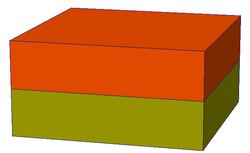Corner-point grid
In geometry, a corner-point grid is a tessellation of a Euclidean 3D volume, where the base cell has 6 faces (hexahedron).
A set of straight lines defined by their end points define the pillars of the corner-point grid. The pillars have a lexicographical ordering that determines neighbouring pillars. On each pillar, a constant number of nodes (corner-points) is defined. A corner-point cell is now the volume between 4 neighbouring pillars and two neighbouring points on each pillar.
Each cell can be identified by integer coordinates [math]\displaystyle{ (i,j,k) }[/math], where the [math]\displaystyle{ k }[/math] coordinate runs along the pillars, and [math]\displaystyle{ i }[/math] and [math]\displaystyle{ j }[/math] span each layer. The cells are ordered naturally, where the index [math]\displaystyle{ i }[/math] runs the fastest and [math]\displaystyle{ k }[/math] the slowest.
Data within the interior of such cells can be computed by trilinear interpolation from the boundary values at the 8 corners, 12 edges, and 6 faces.
In the special case of all pillars being vertical, the top and bottom face of each corner-point cell are described by bilinear surfaces and the side faces are planes.
Corner-point grids are supported by most reservoir simulation software, and has become an industry standard.
Degeneracy
A main feature of the format is the ability to define erosion surfaces in geological modelling, effectively done by collapsing nodes along each pillar. This means that the corner-point cells degenerate and may have less than 6 faces.
For the corner-point grids, non-neighboring connections are supported, meaning that grid cells that are not neighboring in ijk-space can be defined as neighboring. This feature allows for representation of faults with significant throw/displacement. Moreover, the neighboring grid cells do not need to have matching cell faces (just overlap).
References
- Corner Point Grid. Open Porous Media Initiative
- Aarnes J, Krogstad S and Lie KA (2006). Multiscale Mixed/Mimetic Methods on Corner Point Grids. SINTEF ICT, Dept. Applied Mathematics
 |


